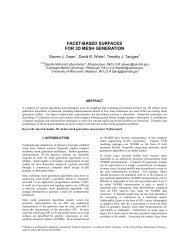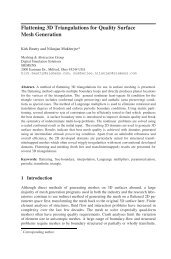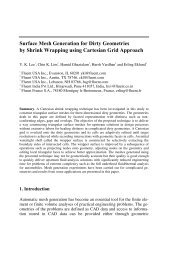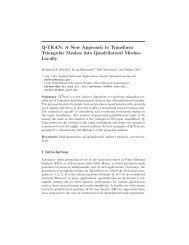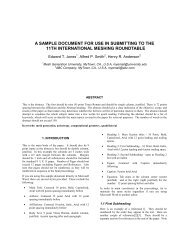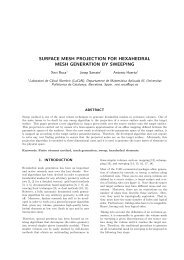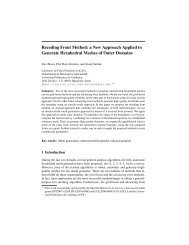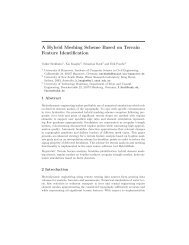Fitting Polynomial Surfaces to Triangular Meshes with Voronoi ...
Fitting Polynomial Surfaces to Triangular Meshes with Voronoi ...
Fitting Polynomial Surfaces to Triangular Meshes with Voronoi ...
Create successful ePaper yourself
Turn your PDF publications into a flip-book with our unique Google optimized e-Paper software.
10 Vincent Nivoliers, Dong-Ming Yan, and Bruno Lévy<br />
Fig. 6: Computing the gradient of the symmetric term ∇ ˜F S→T : configurations of<br />
the vertices of Vor(Y)| S .<br />
where dA/dB = (∂a i /∂b j ) i,j denotes the Jacobian matrix of A.<br />
The set of possible configurations for a vertex c k is similar <strong>to</strong> the combina<strong>to</strong>rial<br />
structure of the L p -CVT function [11], <strong>with</strong> the exception that the roles of<br />
the variables and constants are exchanged. Each configuration yields a Jacobian<br />
matrix that propagates the derivatives of ˜F T S→T from the c k’s <strong>to</strong> the x i ’s.<br />
There are 3 possible configurations (see overview in Figure 6) :<br />
→ c is a vertex x i of S (then dc/dx i = I 3×3 ) ;<br />
→ c has configuration (a) :<br />
c corresponds <strong>to</strong> the intersection between the bisec<strong>to</strong>r of [y 1 , y 2 ] (left,<br />
plane shown in blue) and an edge [x 1 , x 2 ] of S (right). The Jacobian matrices<br />
dc/dx 1 and dc/dx 2 are given in Appendix B, Equation 13;<br />
→ c has configuration (b) :<br />
c corresponds <strong>to</strong> the intersection between the three bisec<strong>to</strong>rs of [y 1 , y 2 ],<br />
[y 2 , y 3 ], [y 3 , y 1 ] (left) and a facet (x 1 , x 2 , x 3 ) of S (right). The Jacobian matrices<br />
dc/dx 1 , dc/dx 2 and dc/dx 3 are given in Appendix B, Equation 14.




